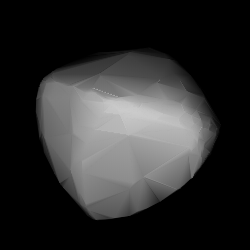|
3174 Alcock
3174 Alcock (prov. designation: 1984 UV) is a carbonaceous Themistian asteroid from the outer region of the asteroid belt. It was discovered by American astronomer Edward Bowell at Lowell's U.S. Anderson Mesa Station in Flagstaff, Arizona, on 26 October 1984.[6] The likely C-type asteroid has a rotation period of 7.1 hours and measures approximately 19 kilometers (12 miles) in diameter. It was named after British amateur astronomer George Alcock (1912–2000). Orbit and classificationThe dark C-type asteroid is a member of the Themis family, a dynamical family of outer-belt asteroids with nearly coplanar ecliptical orbits. It orbits the Sun in the outer main-belt at a distance of 2.6–3.7 AU once every 5 years and 7 months (2,038 days). Its orbit has an eccentricity of 0.17 and an inclination of 2° with respect to the ecliptic.[1] The first used observation was taken at Crimea–Nauchnij in 1973, when the body was identified as 1973 YO1, extending its observation arc by 11 years prior to the official discovery observation. However, the first images were already taken at the U.S. Goethe Link Observatory in 1962, while it was identified as 1962 YD.[6] NamingThis minor planet was named by the discoverer for prolific British amateur astronomer George Alcock (1912–2000), who visually discovered 5 comets and 4 novae.[2] The naming was published by the Minor Planet Center on 5 November 1987 (M.P.C. 12458).[7] Physical characteristicsA rotational lightcurve of this asteroid was obtained from photometric observations made by French astronomer René Roy in February 2008. The lightcurve gave a rotation period of 7.05±0.01 hours with a brightness variation of 0.65 in magnitude (U=3-).[5] According to the spaced-based survey carried out by the Japanese Akari satellite, the asteroid measures 18.66 kilometers in diameter and its surface has an albedo of 0.102,[4] while the Collaborative Asteroid Lightcurve Link assumes an albedo of 0.08 and calculates a diameter of 18.71 kilometers.[3] References
External links
|
||||||||||||||||||||||||||||||||||||||||||||||||||||||||||||||
